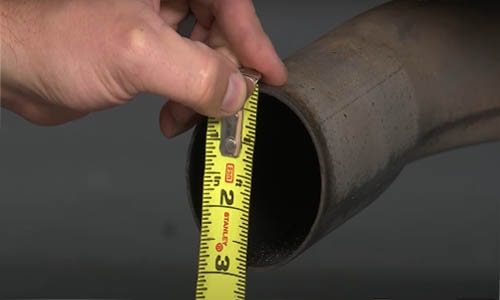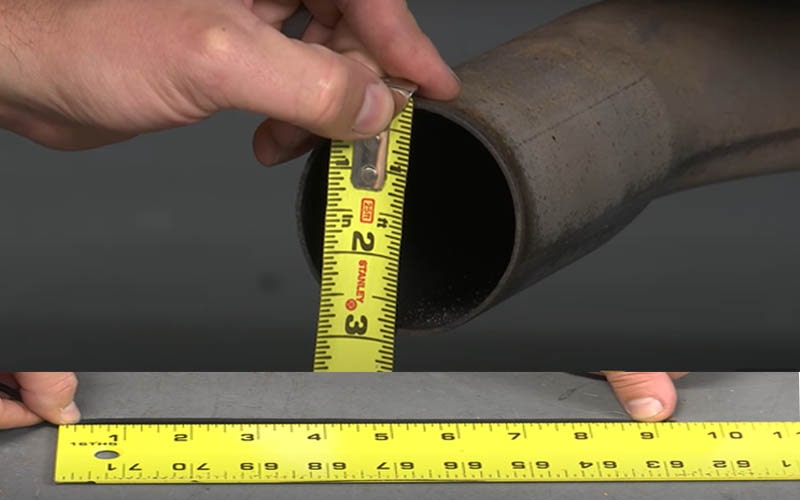Poor performance of a vehicle can be the result of installing an incorrect exhaust pipe. Now, how would you find the correct size of exhaust pipe only specified for your vehicle?
So, how to measure exhaust pipes? Well, you need to follow a simple method by using a measuring tape. Measure the outside diameter of the pipe if the pipe has a defined circle. Or else, take the help of a string to measure the size of the pipe. Lastly, match the obtained size with the closest size for exhaust pipes.
A correct exhaust pipe improves fuel efficiency and functionality of the engine. To help you out, the precise measuring method for the exhaust pipe is included below. Let’s dive into it!
What Does An Exhaust Pipe Do?
The exhaust pipe is the part of the exhaust system that carries harmful gas and fumes out of the vehicles’ engines and cabins. Generally, the exhaust system gathers exhaust gasses from the cylinders. Then, the collected gas passes through the exhaust pipe while being converted into a less toxic end product.
Apart from making the expelled gasses less toxic, the pipe also ensures to emit the harmful gasses that can cause damage to the engine. The longer the gasses stay in the exhaust pipe, the more it decreases the performance of the vehicle.
But, an efficient and the right exhaust pipe helps to remove the toxic gasses as soon as possible from the vehicle. Thus, it allows fresh oxygen that results in increasing the performance of the vehicle. Faster oxygen intake results in making complete use of the fuel. Meanwhile, complete utilization of the fuel also contributes to increasing fuel efficiency.
Furthermore, maximizing adequate fuel usage is facilitated by the quick departure of gasses through the exhaust pipe. However, it also contributes to reducing the noise when the gas passes through the exhaust pipe.
Standard Sizes Of An Exhaust Pipe
The standard sizes of exhaust pipe for different engine size and exhaust system is tabulated below:
|
Engine size (CI) |
Horsepower (HP) | Single exhaust system |
Double exhaust system |
|
150-200 |
100 | 2” | 2”-2 ¼“ |
|
150 |
2 ¼” |
2”-2 ¼“ |
|
|
200 |
2 ½” | 2”-2 ¼“ | |
|
200-250 |
150 |
2 ¼“ | 2”-2 ¼“ |
|
200 |
2 ½” |
2”-2 ¼“ |
|
|
250 |
2 ½” |
2”-2 ¼“ |
|
| 250-300 | 200 | 2 ½” |
2 ¼ “ |
| 250 | 2 ½” |
2 ½” |
|
|
300 |
3” |
2 ½” |
|
|
300-350 |
250 |
3” |
2 ½” |
|
300 |
3” |
2 ½” |
|
|
350 |
3½” |
2 ½” |
|
|
350-400 |
300 |
3” | 2 ½” |
| 350 | 3½” |
2 ½” |
|
|
400 |
3½” | 2 ½” | |
| 400-450 | 350 | 3½” |
2 ½” |
|
400 |
4” | 3” | |
| 450 | 4” |
3” |
|
|
450-500 |
400 |
4 ½” | 3 ½” |
| 450 | 4 ½” |
3 ½” |
|
| 500 | 4 ½” |
3 ½” |
Things You Should Know Before Measuring An Exhaust Pipe
The size of the exhaust pipe is specified for different vehicles. Still, the owner can upgrade the size of the pipe according to the need. However, the upgraded pipe might not always work effectively for the vehicle.
For choosing the correct exhaust pipe for the vehicle, you should consider the following things.
Engine Size:
Engine size is the first thing to consider before measuring an exhaust pipe. According to the engine size, the vehicle requires a specified size of pipe. For example, larger engines give off a larger amount of mixture of gasses. This results in a larger amount of gas emission. Consequently, it requires a large exhaust pipe.
Moreover, installing an incorrect-sized pipe would affect the flow of gas through the exhaust pipe. And the overall performance of the engine would also get disrupted. That’s why using the correct size exhaust pipe is always recommended.
Performance:
The performance of the vehicle is highly affected by the emission of gas from the vehicle. Well, when the fuel gets utilized, the cylinders release the gas. And the faster the gas travels outside the vehicle, the better the performance of the car will be.
That’s why many recommend installing larger-sized exhaust pipes. But, it will also add cost and facilitate other problems, which are also described in the below section. Instead, measuring the exact size of the exhaust pipe should be given priority.

Sound Preference:
The exhaust pipe also influences the noise in the vehicle. Large-sized pipes tend to give off more sounds than smaller ones. Well, the sound is also affected by the resonance system mainly. All the associated parts will also require to be changed due to changing the pipe size.
Single And Double Exhaust Systems:
The single exhaust system only has one pipeline moving toward the outside. On the other hand, a double exhaust system contains two pipelines to release the gas. Two pipelines work more efficiently by increasing the flow of gas and removing the gas faster. However, not all cars facilitate the double exhaust system.
However, the size of the exhaust pipe would also vary with the exhaust system that the car comes with.
Associated Parts:
The exhaust system consists of the exhaust manifold, oxygen sensor, catalytic converter, and exhaust muffler. Well, all these parts collectively work to get the gas out of the vehicle. The exhaust manifold collects the gas and moves the gas through the exhaust pipe.
In the pathway, the gasses get reduced to less toxic components. All these parts come in a standard size for each car. That’s why the exhaust pipe should be installed while considering the associated parts and specifications of the vehicle.
How To Measure Exhaust Pipe Properly?
Correct measurement of the exhaust pipe is required to ensure the increasing performance of the vehicle. The thickness of the exhaust pipe is generally kept between 1.5-1.6 mm. So, measuring the size does not require measuring the thickness. Any pipes in the marketplace will come with this desired thickness.
Furthermore, you can follow the below steps to measure the size of the exhaust pipe.
Step 1: Measure The Outside Diameter
Generally, the outside diameter (OD) of the exhaust pipe is taken as the size of the pipe. If the pipeline stands out, you can easily measure the end of the pipe and the diameter. Especially when the pipe has a defined circular end with no alteration. To measure the diameter, take a measuring tape or ruler.
- Now, hold the tape or ruler from one end of the outside to the other end of the outside of the pipe.
- Measure the pipe while keeping the circular center in the middle and holding the tape straight from up to down.
- Mark the measurement and note it down.
This is the observed diameter of the exhaust pipe. Now, match it with the nearest available pipe size to get the correct size.
Step 2: Measure The Circumference
If the pipe does not have a perfectly circular shape, you need to measure the pipe from the center. To measure the middle circular diameter of the pipe, you need to find the circumference. To measure the circumference, you need a rope or string. Remember, the string should not be elastic.
Now, hold the rope around the pipe and measure the circumference. Do not stretch the rope. Just hold it, not too tight or too softly. Lately, mark the measurement. Then, put it on the ruler to get the correct measurement of the circumference.
Afterward, divide the circumference by pi, which is 3.1416, to get the diameter. This is the observed diameter of the exhaust pipe. You should now match the exhaust pipe size with the nearest pipe size.
For example, if your obtained diameter of the pipe is 2.60”, what should be the size of the pipe? In that case, the nearest available pipe size is 2.50” and 2.75”. Well, you should take the pipe of 2.75” as the other one might become small for the vehicle. The nearest pipe size is, generally, the correct size of the pipe. Comparing the sizes is important as you might not get a round figure.
Necessity Of Perfect Measurement Of Exhaust Pipe
Exhaust pipe measurement is required to install it in the vehicle efficiently. Well, the exhaust pipe should be chosen according to the specifications of the car engine. The main function of the exhaust pipe is to expel the gasses as fast as possible without any hindrance. Engine size highly influences the size of the exhaust pipe. As the amount of gas discharged from cylinders also influences their flow through the exhaust pipe.
Moreover, putting a large size exhaust would not help as the amount of expelled gas would not be changed. Rather, it will put the engine under pressure to work hard.
Also, it can create too much back pressure that can hamper the power production of the engine. It can also reduce fuel efficiency. Associate parts with the exhaust system, such as resonance and muffler size, will also need to change following the exhaust pipe. So buying the larger pipe will only cost money.
On the other hand, choosing smaller-sized pipes can be an obstacle to the flow of gas. As the steady flow gets hampered, it gives load to the exhaust system. The excess pressure can also damage the pipe. And does not let the gas out of the pipe efficiently.
That’s why choosing the optimum pipe size according to the manufacturer’s specifications should be given priority.
Conclusion
Overall, how to measure exhaust pipes seems easier as long as you know the correct method. You can measure the size by measuring the diameter directly of a circular pipe. Or else you can determine the circumference first and then find the value of the diameter.
In both ways, you can get the correct diameter for the pipe. However, you can also upgrade the pipe size if required. Remember to choose the correct pipe size for the vehicle to get the best performance of the car.

